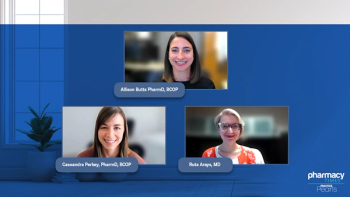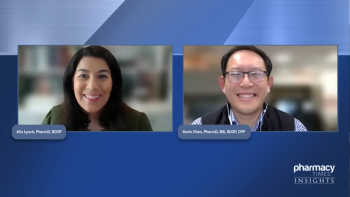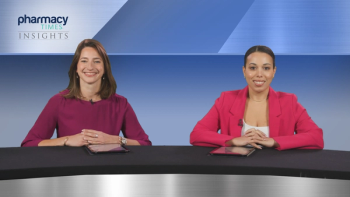
Progression-Free Survival and Overall Survival Associated With CDK4/6 Inhibitor Therapy
Expert panelists discuss the impact of CDK4/6 inhibitor therapy on progression-free and overall survival.
Ryan Haumschild, PharmD, MS, MBA: What is progression-free survival? How do you utilize that when you’re in clinical practice, maybe in conjunction with overall survival or separately? And what does the data demonstrate with the effects of CDK4/6s [cyclin-dependent kinase 4 and 6] on PFS, or progression-free survival?
Rose DiMarco, PharmD, BCPS, BCOP: Progression-free survival is the time from when a patient starts treatment to when they start to progress or until death. I use progression-free survival in clinic when I’m talking to my patients. This is all part of the education. This is part of my goals for their adherence. I think if they understand why we give them medication, they’re more likely to take it. That’s where I think progression-free survival comes in. It’s really helpful for me to [tell patients that] all 3 of these drugs have shown that the progression-free survival is better when you give a CDK4/6 inhibitor plus endocrine therapy vs endocrine therapy alone. This is the median amount of time that patients have stayed on treatment without progression. I think that’s where it really hits home. It’s easier to explain why we’re giving something when we can give them actual numbers. In most cases, the CDK4/6 inhibitors, for example, Verzenio or abemaciclib, has about almost double the progression-free survival than endocrine therapy alone. That is really significant. We’re talking over 2 years for patients, and that’s just the halfway point. That really gives them the motivation. I think they need to take the adverse effect information that we’re giving and put it into perspective.
Ryan Haumschild, PharmD, MS, MBA: Excellent. Having a patient understand what progression-free survival looks like and overall survival—we’re so used to communicating in those terms and utilizing that as part of our NCCN [National Comprehensive Cancer Network]-based evaluation. But I think overall, a patient needs to understand it as well, and it’s helpful when they can understand that there truly is a benefit here, whether it’s around progression [or] whether it’s overall survival. When we’re looking at other things that come into play, like dose reductions. Even though we don’t need a dose reduction, you still might be successful in therapy. Dr Moore, you’re in clinic, you’re working with these patients all the time. I’m sure that dose reductions due to adverse effects might be a normal course of a patient’s therapy. It builds on the discussion that you and I had about having clear expectations on the front end. “Hey, you might have a dose reduction, that might be a bad thing or might not.” Dr Moore, I think you are positioned best to talk about pharmacists and yourself, and how do you go about having the conversations around dose reductions? How do we identify them? What do you talk to the patient [about]? What would cause the overall dose reduction during a course of treatment? Lastly, what is the effect of dose reductions, let’s say, on ribociclib in terms of overall survival?
Heather Moore, CPP, PharmD, BCOP: Those are all great points. I think as you mentioned, when you’re discussing with the patient and going over therapy, it’s always great to give up-front information in terms of [the] reasons that we would consider doing a dose reduction. When you’re going over the adverse effects, I always try to put it in terms of something that is more comforting and makes more sense. I say it’s not a one-size-fits-all. In that instance, sometimes doing the highest dose may not be the right dose for you. We have adequate data to show us that even in the settings of dose reductions with ribociclib or most recently with the abemaciclib that we’ve seen in ASCO [American Society of Clinical Oncology] recently, that dose reductions do not impact efficacy. I think that’s something that’s really important when you’re conveying that information to patients, because sometimes their concern is, “Well, I’m going to stick out with the adverse effects.” I’m going to do that because I want to make sure that I’m getting the most efficacy that I can from their therapy. Sometimes they’re really frightened to do a dose reduction. I always want to tell them up front that when we’re doing therapy, this is a combination of one, we want efficacy from the drug, but we want to make sure that you’re maintaining your quality of life at home. Those things are both very important. Otherwise, we’re not doing any favors. I always like to emphasize when we may be doing dose reduction, whether that be for neutropenia or whether that be fatigue, maybe that’s from adverse effect management like diarrhea [or] things of that nature. It’s also important, pivoting to the multidisciplinary team, that we’re pharmacists, that’s what we do. It’s important that we know what the dose reductions are, and then when we actually need to do a dose reduction or maybe we just need to do a hold and wait for a count recovery, maybe we can retrial at the same dose or, pending what that looks like, sometimes it is not exactly a science, and saying, “Well, this was quite a big drop, maybe we do need to consider going ahead and doing a dose reduction from a counts perspective.” Then sometimes, like I said, we can continue on the same dose and sometimes maybe we can do a dose reduction. But knowing when you need to do one vs another [is vital]. Like I said, sometimes for some patients it’s not a bad idea to start at a lower dose and then dose escalate vs going in the other direction. I think all of those things are important when we’re thinking about therapy with our patients.
Ryan Haumschild, PharmD, MS, MBA: There are a lot of key takeaways there. I think the first is in a patient. Sometimes they’re like, “I’m afraid to tell them that I have an adverse effect because I don’t want them to change the dose because I want to make sure I get the right potency to help treat my cancer.” Very clearly the data are showing that a dose reduction is still going to be part of your journey. That’s going to be okay. It’s going to provide really great outcomes. I think the more patients understand that more even on the up-front, they recognize, hey, you’re going to see some of these adverse effects potentially, and you’re going to see dose adjustments. Don’t let that concern you. Don’t hold back talking to us as a team or your pharmacist that you might be experiencing an adverse effect. We’re here, we’re prepared. Then what I also love is the competency that our pharmacists have around, when is it a dose hold? When is it a dose reduction? When is it abandonment of therapy as a whole? Being familiar not just with the package insert but the clinical trial data that help drive some of those decisions, and then maybe even taking it a step further for some of us who have oral agents and plans. How do we build in those dose reductions? It’s a more of a simple click, and we have more structure and rigor and oversight to it that can really complement that decision-making process. Ultimately we want that patient, when appropriate, to receive a dose reduction, have a better quality of life, not want to abandon therapy, and maybe that duration of treatment can be just as long or even better than we saw in the clinical trial. I know that’s always our goal is, how do we evaluate what that real-world duration of treatment [looks] like? Is it comparing to the clinical trial, and are we doing everything we can to keep that patient successful in therapy?
Transcript is AI-generated and edited for clarity and readability.
Newsletter
Stay informed on drug updates, treatment guidelines, and pharmacy practice trends—subscribe to Pharmacy Times for weekly clinical insights.


